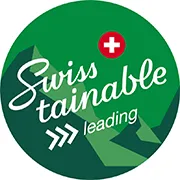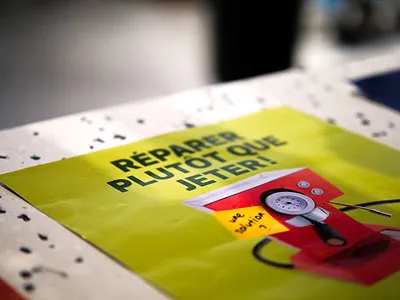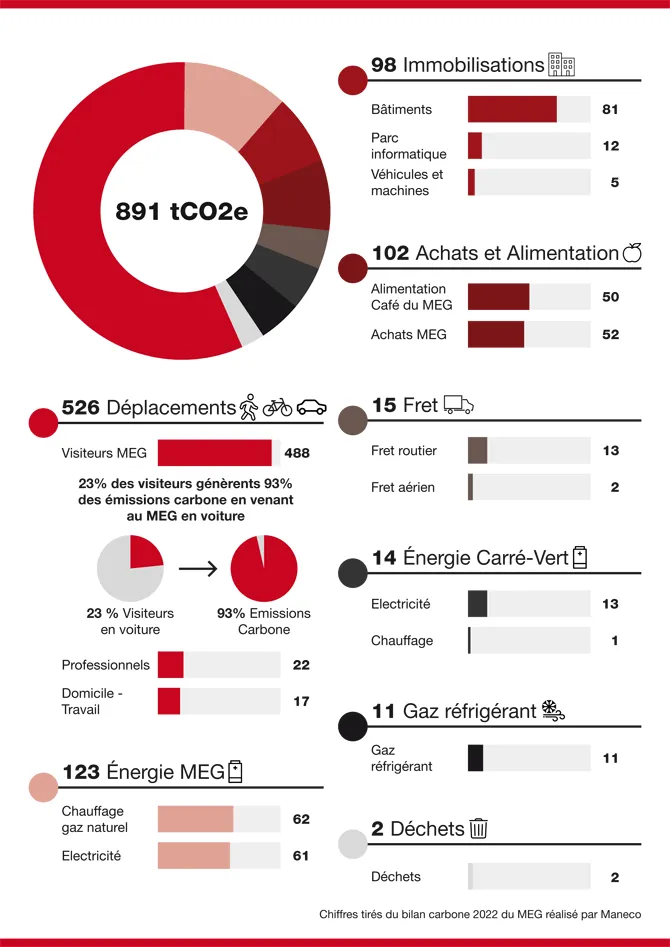A sustainable and responsible museum
MEG's sustainable commitment rewarded by the THQSE label with the GOLD level
MEG has received the international THQSE label (Very High Social-Social-Health and Environmental Quality) at the GOLD level (its highest level of excellence) and is the first THQSE-labeled museum in Europe and the first organization in Switzerland !
This label certifies the social, societal, economic and environmental actions that the MEG has been implementing for several years.

Swisstainable III is the most demanding level of Switzerland Tourism's sustainability program.

MEG's CSR approach recognized by the international Responsibility Europe label
«Goo dip dm wilaagwa ha’lidzog̱, ‘nii dm di la waal das lip ‘nüüm.»
«What we do to the world, we do to ourselves.»
Huk Tgini'itsga Xsgyiik - Gavin Hudson
Peuple Ts’msyen, Alaska
A strong commitment to sustainability
MEG's vision is articulated in a clearly defined strategy (see its Strategic Plan 2020-2024) in which environmental and societal awareness is formalized. MEG's objective is to become a reference museum in terms of sustainable development.
What is a sustainable and responsible museum?
Sustainable development is " development that meets the needs of the present without compromising the ability of future generations to meet their own needs" (Brundtland Report, 1987).
By implementing sustainable development management, museums assume their responsibility as key players in rethinking the future of our planet and society in general.
In its desire to concretely integrate the concept of sustainability within the Museum, MEG is committed to :
- Reducing its carbon footprint to reduce the pressure exerted by human beings on the planet's ecosystems;
- To act on a daily basis by implementing significant qualitative and quantitative measures;
- Raising awareness, informing and engaging in debate with its audiences through exhibitions and cultural, artistic and scientific programming that resonate with the crucial issues of our time.
MEG's commitments in the area of CSR
As a museum committed to sustainability, MEG has taken on the notion of Corporate Social Responsibility (CSR).
For MEG, the principles of this approach can be summarized as the integration of sustainability (in the short, medium and long term) into its strategic objectives while taking into account the effects and impacts that the institution has on society and the environment as a whole.
As a municipal museum, MEG is situated in a political context that is very committed to the integration of sustainability. The Museum has thus developed its strategy in line with the Climate Policy of the City of Geneva and the Roadmap of the Department of Culture and Digital Transition.
As part of a national and international dynamic, MEG is also integrated into the Cantonal Climate Plan of the State of Geneva, the Federal Council's Sustainable Development Strategy 2030, as well as the UN Sustainable Development Goals, the universal keystone of the Agenda 2030.
A label to certify MEG's social and environmental commitment
For many years, MEG has been actively committed to sustainability, both in its operations and in its activities for the public.
In order to affirm its social and environmental commitment, MEG has undertaken in 2021 a process of evaluation recognized in Switzerland and internationally according to the THQSE label and approach (Very High Social-Social-Sanitary and Environmental Quality). This process consists of evaluating the work already done, estimating the environmental and global impacts of the institution in order to reduce them in a sustainable manner, as well as finding concrete solutions for a continuous improvement of its carbon footprint.
The objective is to have an independent and international accredited organization carry out a sustainability and eco-responsibility assessment in 2022 in order to certify the actions carried out within MEG over the past several years with a view to obtaining an eco-label.
CSR at the heart of MEG's actions
MEG implements its CSR (Corporate Social Responsibility) strategy based on an action plan built around four pillars: environmental, social, economic and societal.
MEG's CSR approach also consists in moving towards structured and harmonized actions.
PILLAR 1
MEG's environmental commitment

The objectives
MEG has set itself the objective of becoming a reference museum in the field of sustainable development. To this end, it has proactively taken on the environmental field and has taken on the major ecological issues that affect the building as well as air and water quality, energy consumption, waste sorting and the recycling of residual materials. The protection of biodiversity closes this field, opening up inspiring perspectives in terms of cultural and educational mediation.
The Museum is piloting its ecological transition with several large-scale projects such as the introduction of an eco-responsible work culture, or the drafting of a strong and binding ecological charter for exhibition scenography.
Raising awareness among staff and the public about eco-actions and climate issues is dealt with in a transversal and active manner, notably through public meetings to reflect and act together, which propose concrete solutions.
The field of transport leads to a global reflection on the issue of mobility. It concerns both the encouragement of soft mobility for staff and the question of pooling the transport of works or a responsible artistic programming strategy.
Actions taken
All exhibition scenographies are conceived and built in an eco-responsible manner: use of local materials, reuse or recycling of materials or exhibition elements after use, etc.
All documents published by the Museum (with the exception of posters) are printed according to ecological principles (sustainable printing press, cold technology, no ozone emissions; Blue Angel label; 100% recycled FSC paper; inks based on mineral oil and natural pigments; 100% recyclable cardboard ink cartridges).
Actions to reduce carbon emissions linked to the transport of works of art are carried out, such as the organization of grouped and shared transport, the reuse of crates of works of art, the use and/or reuse of eco-designed materials for the protection and/or cushioning of the works.
PILLAR 3
MEG's economic commitment

The objectives
As a public institution, MEG must be attentive to the economic aspects of its structure, such as the governance of the institution, budget management, responsible purchasing and the quality of its services.
MEG's governance is constituted by a Board of Directors that takes concerted and collegial decisions. It is the responsibility of this body to develop the mechanisms and methodologies that allow the implementation of the objectives of the Strategic Plan. MEG's governance establishes collaboration between the different sectors of the institution and fosters a collaborative work culture in a healthy and serene climate.
MEG's budget, derived from public funds, requires that responsible spending be considered. The Museum therefore favors the 5Rs rule (reuse, repair, recycle, reduce, renounce) in all its areas of activity.
At MEG, the issue of responsible purchasing is directly linked to the purchasing policy of the City of Geneva. Most of these purchases are centralized and made through the Municipal Purchasing and Printing Center (CMAI) within the framework of public contracts.
The question of quality takes into account the social and solidarity economy as well as the attention paid to human rights by MEG's main suppliers and external service providers. Before purchasing any consumer products (office equipment, cleaning products, construction materials, etc.), the institution analyzes their production methods and internal use, using eco-responsible labels.
Actions taken
The Museum has undertaken to formalize and structure its CSR approach through the implementation of a blank audit, with a view to obtaining an eco-label.
A "responsible digital" action plan has been implemented in all sectors of MEG.
Purchases made directly by MEG outside of public contracts meet eco-responsible criteria according to the 5R cycle: reuse, repair, recycle, reduce, renounce.
In the context of the selection of the scenographer for the exhibitions, the evaluation criterion concerning the ecoresponsible aspect is weighted at 20%. Materials are recycled within the framework of the social and solidarity economy: elements made by associations, schools, donations to other organizations, collaboration with the association "Matériuum", etc. The circular economy is applied in various fields, for example by working with eco-responsible service providers and/or suppliers, by developing sharing, lending, renting, extending the duration of use, recycling and recovery of equipment and materials.
PILLAR 4
MEG's societal commitment

The objectives
The societal pillar is the field of CSR that addresses the anchoring of MEG in its territory, as well as its relations with its stakeholders (public, cultural partners, service providers, suppliers, artists, politicians, patrons, sponsors, other cultural structures, associations, organizations from other sectors of activity).
To clarify the roles and responsibilities of MEG and its stakeholders in the context of cultural programming, the Museum has defined and published a Cultural Programming Policy, in which it defines the desired modalities of collaboration, including equitable participation in the decision-making processes. It should be noted that this policy was built in a co-construction process that involved stakeholders.
In addition, MEG intends to reinforce and formalize its role as a place contributing to the well-being of the public, whether they are healthy or not, by developing actions aimed at the beneficiaries of hospital structures.
The Museum actively participates in a decolonial critique of Swiss cultural institutions. The decolonial approach of MEG consists in positioning it at the heart of a network of partners carrying out research in collaboration with the bearers of the cultures concerned. This approach encourages the revitalization of cultural practices within societies through artistic and educational projects carried out in co-construction.
Actions taken
The institution promotes sustainable development among the public (awareness-raising for all audiences through the themes of the activities and exhibitions) and in particular among the younger generations (future and young parents, primary and secondary schools).
MEG examines the provenance of its collections by addressing more precisely the history of the so-called "sensitive" collections which demonstrate the asymmetry of the exchanges between the former collectors and the producers of the goods kept in the Museum.
MEG intends to open its storerooms and archives more widely to the communities of origin in order to anchor in its practices the notion of the proper treatment of objects and to promote a shared management and development of the collections.
MEG is actively engaged in the field of museum welfare. It collaborates with the hospital community on the benefits of culture and the role of the arts in improving health. The Museum and the cardiology department of the HUG have set up a pilot project that integrates visits to the Museum's exhibitions and workshops into the rehabilitation program for people who have suffered a cardio-vascular accident.
Educational guide to MEG's commitment to sustainability
Are you a cultural institution? A person in charge of sustainability? Interested in finding out more about MEG's commitment to sustainability? This educational guide is for you!
In 2023, we were awarded the international THQSE (Très Haute Qualité Sociale, Sociétale et Environnementale) label. This label is a recognition and certification of the social, societal, economic and environmental actions we have been implementing for several years.
This pedagogical guide will enable you to find out more about the methodology implemented at MEG. You'll find the resources we've drawn on, answers to your most frequently asked questions, and advice based on the lessons we've learned from our experience as Europe's first RSO-labeled museum!
Carbon footprint
MEG presents its carbon footprint: a concrete commitment to climate emergency.
In a resolutely sustainable approach, MEG, the Museum of Ethnography in Geneva, announces the completion of the carbon footprint assessment of its activities for the year 2022. This study, conducted in the context of climate emergency, aims to evaluate the greenhouse gas (GHG) emissions generated by all of the MEG's activities. By highlighting the most significant emission sources, the Museum aims to define strategic directions to reduce its carbon footprint in the short and medium term.
The main conclusions of this study reveal carbon emissions of 891 tCO2e for the year 2022, equivalent to the emissions of 70 Genevans over 1 year. The emission category "Transportation" alone accounts for 59.1% of the GHG emissions, of which 55% represent the travels of the museum's 100,000 visitors and customers of the MEG Café. Following are emissions related to "Energy," which make up 15.4% of the carbon footprint, with electricity being the main category (equivalent to the annual electricity consumption of 289 households); then "Purchases and Food" (11.4%), half of which corresponds to food purchased for the MEG Café, and "Investments" (11.0%) represented by buildings.


MEG Objective: To aim for an 85% reduction in GHGs by 2030 and carbon neutrality by 2050
The MEG, firmly committed to sustainability, has set ambitious objectives aligned with the climate commitments of the City of Geneva. It thus commits to aiming for an 85% reduction in its greenhouse gas emissions by 2030 and achieving carbon neutrality by 2050.
Concrete actions for an energy transition
Following the results of the carbon footprint assessment, MEG reveals its action plan articulated around several priority areas:
- Encouraging visitors to adopt soft transportation modes or carpooling.
- Encouraging the City of Geneva to opt for 100% green energy provided by SIG and for biogas heating.
- Encouraging the MEG Café to increase its vegetarian offerings.
- Reducing individual motorized travel by MEG staff and limiting air travel.
- Deepening the topic of eco-design in all sectors following a formalized protocol, promoting reuse, and favoring local actors for the purchase of exhibition materials.
- Rationalizing artwork transport by grouping and sharing transports.
- Appointing an energy referent within the Museum to oversee the implementation of these measures.
Carine Ayélé Durand, director of the MEG, emphasizes the importance of this approach: "The environmental crisis is one of the major challenges of our time. MEG, as the Museum of the City of Geneva, actively participates in the collective effort. It is essential for MEG to undertake original thinking, in-depth analysis, and concrete actions to address this great challenge with the contribution of our audiences and partners."
MEG undertook this carbon footprint assessment as part of its commitment to sustainability and in line with the Climate Strategy of the City of Geneva. As a public institution, the Museum explores the best ways to initiate an energy transition, benefiting from the support offered by the City of Geneva.
Synthèse du Bilan carbone et
plan d’action 2030 du MEG
[PDF 0.2 Mo]
For any questions regarding MEG's sustainable and responsible commitment, you can contact the RSO representative, Cendrine Hostettler, at cendrine.hostettler@ville-ge.ch
